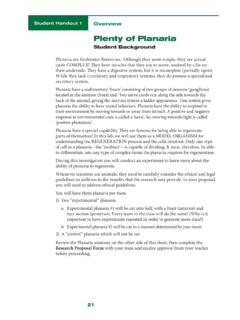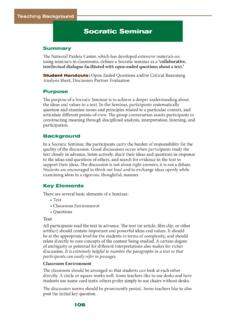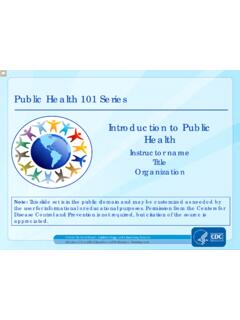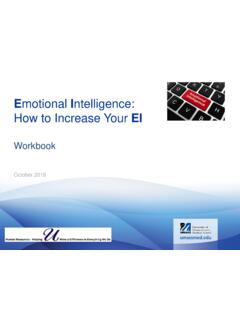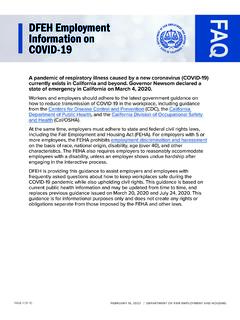Transcription of Decision-Making Frameworks
1 12 3 Decision-Making FrameworksThe strength of Decision-Making Frameworks or Models is that they provide a structured format for student thought. In teaching Frameworks to students, teachers have found it helpful to begin with a familiar example or have students consider how they themselves make decisions (see Lesson Strategies section for ideas about how to introduce these models).The model provided here is based upon one developed by the Hastings Center on Bioethics (Campbell, 1990) and has been widely used by educators in science classrooms. It has the following components: Ethical QuestionFirst, the Decision-Making framework asks students to consider the ethical question.
2 This is in itself not trivial awareness that an ethical dilemma actual exists requires moral sensitivity (Rest, 1984) which often needs to be cultivated. Often, students will identify the ethical question only to return to modify it later. An ethical question often (but not always) includes the word should , and it is characterized by the fact that several competing solutions exist. In reflection on the moral nature of the dilemma, none of these solutions is without its problems, concerns, or issues. Examples of such questions include, In which cases, if any, is the use of animals in research ethically justified?
3 Is it ethical for scientists to pursue embryonic stem cell research? or How should donated organs be allocated? Facts: Known and UnknownStudents then determine which facts relevant to the question are known and which still need to be researched. If time permits, students can research the issue more deeply. This is an excellent place to incorporate additional science content. From additional research, or from content provided by the teacher, students identify stakeholders and their values. Stakeholders and their ValuesOne of the most rewarding aspects of having students consider the position and values of different stakeholders is that it asks them to step into someone else s shoes.
4 While this is a valuable exercise at any age, it is particularly important for young people, who may struggle to view dilemmas from different perspectives. Such practice is also important for developing citizenship skills in students. In order to participate effectively in a pluralistic, democratic society, students need to be able to understand different perspectives, even though they may not agree with can generate a list of stakeholders with their students, and then, in a classic case-study approach, have students form stakeholder groups representing a single stakeholder position. Students discuss the values their stakeholder might bring to the issue, and the range of positions that the particular stakeholder might take.
5 Next, the teacher can form mixed groups with one representative from each original stakeholder group . This mixed group will try to reach consensus or clarify the nature of their disagreement. This format is also explained in the Lesson Strategies section of the Primer. Possible Solutions - Generating OptionsStudents are asked to generate several options for solutions. This is a brainstorming step, in order to provide a wide range of ideas. Thinking about solutions that different stakeholders would propose is one strategy. Solutions can be analyzed to consider which ethical principles are granted priority in each case.
6 decision and JustificationWhen presented with an ethical dilemma, students are apt to quickly jump to their decision /position, without a sense of their justification. Alternatively, students may express that their position is simply what they believe or what intuitively feels right . The justification of the decision is a key element of the model. This section allows students to practice clarifying their reasoning. Here is where students can bring in their understanding of ethical perspectives and theories (highlighted in the Ethics as a Discipline section) in order to provide depth to their arguments.
7 For example, ethical perspectives can help students clarify which of the possible solutions provides the best outcome for the greatest number (an outcome-based perspective). Action/EvaluationThe last steps consist of acting on the decision and evaluating the decision . Students should be aware that they could change their decisions in light of new evidence or information. Many elements of this problem-solving strategy are shared with scientific Decision-Making processes. The focus is on a reasoned, thoughtful methodology rooted in critical thinking. Additionally, the process of Decision-Making itself should be considered, in order to determine the extent to which it was fair and _____ Date_____ Period_____Student HandoutEthical Question:1.
8 Relevant Facts (known)2. Questions that remain (unknown, need to know)3. Stakeholders (people and/or entities affected by the decision ) ..4. Concerns/Values of each stakeholder ..5. Possible decision Decision-Making framework Modified from the Hastings Center, 1990126 NAME _____ Date_____ Period_____Student Handout WHAT is the ETHICAL QUESTION?II. Gather the FactsKNOWN: What are the relevant facts? What are the essential biological, ethical, economic, social, or political considerations?UNKNOWN: What additional facts, information, or evidence would be useful?Ethical Decision-Making framework (4-page Version)127 Student HandoutWHO are the stakeholders?
9 Which individuals or groups have an important stake in the outcome? Identify the concerns and values associated with each HandoutProsCons Option 1 Option 2 Option 3 12 9 Student HandoutAs you weigh each option, consider the following:Rules/Duties: Does the option help support a good general moral rule for people to follow in similar situations?Virtues: Does the option help support or develop the character traits we value most as individuals and in our society?Outcomes: Does the option produce the most good and do the least harm? Principles: Does the option address the bioethical principles (respect, do no harm/do good, and justice) involved?
10 Care: Does the option focus mostly on protecting vulnerable individuals and maintaining important relationships? What is your decision ? Justify your decision , using the language of ethical concepts and principles described above. VI. Action and EvaluationAfter acting on your decision , you can evaluate it afterwards. You can also consider the process of Decision-Making itself was it fair and just?Modified from the Hastings Center, 1990130 Ethical question clearly identified5 pts: Question that relates to an ethical dilemma clearly pts: Question suggests an ethical dilemma but is ambiguous, vague, or not clearly pts: Question does not clearly relate to an ethical dilemma or is inappropriate for pts: Question not bioethical principles at stake identified and explained5 pts: Principles clearly identified and their logical relation to the ethical question is pts: Principles are identified, but their relationship to the question is illogical or not explained.
